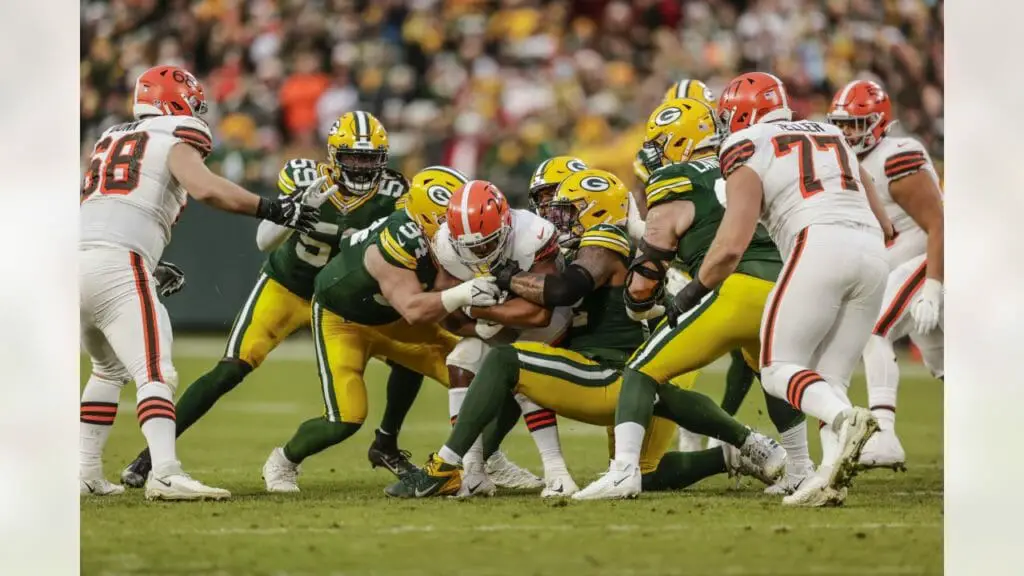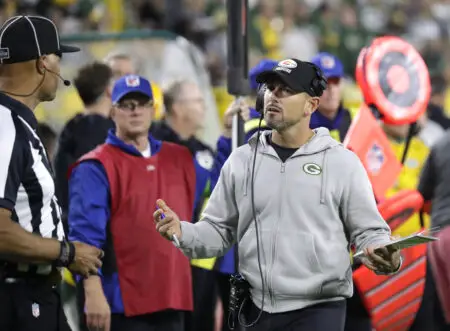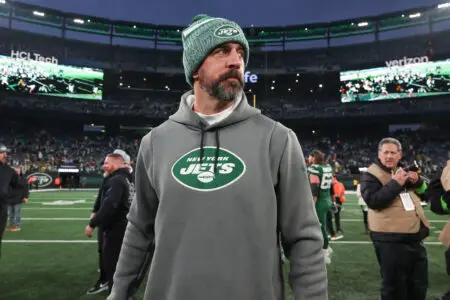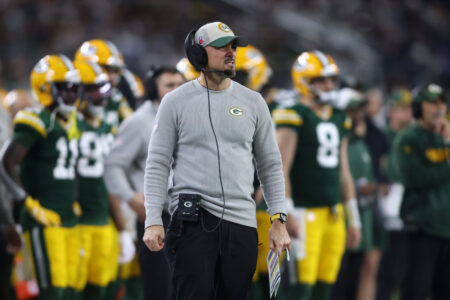As I was watching film of the Packers’ game against the Browns, one thing stuck out to me. The Browns used a variety of run schemes on their way to racking up 219 yards on the ground. However, quite a few of these plays were based off of the same concept. Furthermore, this concept was not one I had seen much from previous Packers opponents. After doing some research – including consulting Coach Cody Alexander, an excellent resource for football insight – I came to the conclusion that this concept was a variation of the Buck Sweep.
The Buck Sweep is a power run concept designed to attack the edges of a defense. In many instances, the Buck Sweep involves both guards pulling and leading the running back off tackle. It originated in the Wing-T system but has also been adapted to fit spread offenses. In this article, I’m going to explore the variation of the Buck Sweep that the Browns used, how they employed it and built misdirection plays off of it, and what adjustments the Packers made – and could’ve made.
The Basic Play Design of the Browns Buck Sweep
The first instance in which the Browns ran their variation of the Buck Sweep was in the first quarter, on the third drive of the game. This play turned out to be their largest gain on the concept, resulting in a 27 yard gain.
There are several key parts to this play. First, the backside tackle and guard cut-block the nose tackle and backside 4i technique. Next, the center and playside guard pull and lead the running back strongside. The playside tackle lays a down block on the 3 technique, while the TE fakes a block on the edge defender then moves up to the second level, sealing off the first defender there. The pulling guard blocks the free edge defender, creating a hole for the center and RB. Depending on the DL alignment, the blocks of the tackles and backside guard change somewhat. However, the structure of the play mostly remains the same.
Why Was It Effective?
This is an excellent play design if executed well. It essentially eliminates the Packers’ main run-stopping resources (the DL), while getting lineman up to the second level. With only one Packers inside linebacker on the field here, it also places perhaps their weakest link on the OL – backup center Nick Harris – in a favorably matchup with a safety. Blocking the edge player with one of the pulling OL also creates a better matchup at the point of attack, while giving the TE nice leverage on the second level. Lancaster, in the playside 3 technique, actually does a nice job fighting across the down block, but can’t disengage to make the tackle.
Although no other instance of this play or its variations achieved the success that this first appearance would, the concept still played a key part in the success of the Browns offense. I found that the Browns gained 77 rushing yards – over a third of their total on the ground – and 88 yards overall on this play and those built off of it. So how did it evolve as the game went on?
The Evolution of the Buck Sweep: The Fourth Drive
The Browns would run their Buck Sweep play again soon after this first instance. On the first play of their next drive, in fact.
The Packers are in their base 3-4 defense this time, with two ILBs on the field. Gary does a nice job crashing in on the pullers, spilling the play for his second level teammates, but neither ILB is in position to take advantage. Barnes doesn’t get off of the TE’s block, and Campbell doesn’t scrape across fast enough – he slows down as he appears to consider shooting inside in an attempt to blow the play up, like in the previous clip. This also leaves him in a bad position to take on the pulling center. Lancaster at 3 tech again fights through the down block, but fails to make the tackle. Finally, the RB bounces off Amos’ tackle for even more yardage.
One Play Later
On the next play of the drive, Cleveland would unveil their first tendency breaker off of this concept, running a play-action design based off of it.
Krys Barnes, flowing with the run action, is caught with bad positioning when the TE coming across the formation runs a route rather than blocking him. Eleven yard gain.
The Browns would run a play similar to the Buck Sweep later on that drive. It’s not identical – it has the playside guard and tackle pulling, rather than the guard and center. The inside tight end in the wing blocks down on the 3 tech. However, it does have similarities in the blocking assignments, so I included it in this analysis. The first puller again engages the unblocked edge, and the TE on the outside of the wing advances to the second level.
This time, the pulling guard is delayed as he helps the center block the shaded nose tackle. Kenny Clark is at 3 tech; he and Gary squeeze the RB’s outside gap. The RB sees the congestion in that direction and cuts back inside. Campbell does a great job reading the RB and disengaging from the TE’s block to make the tackle. You’ll notice that just like the first Buck Sweep run by the Browns, the Packers are in their “Penny” package, which takes off an ILB rather than a defensive lineman in order to put the nickel CB on the field. This time, however, Campbell is shaded to the strong side of the formation rather than mirroring the RB’s position. This gives him a better angle to engage outside runs to the strength of the formation.
The Fifth Drive
Cleveland only turned to this play design once on the subsequent drive, running it on 1st & 20 after a holding call.
The Packers are in their 2 ILB Nickel formation. In addition, Adrian Amos is rotated down into the box. Garvin spills the puller, but Amos is focused on a possible route from the TE rather than flowing to fit the run. He takes a step inside with the TE before rerouting. It’s very possible that he’s thinking about the PA the Browns ran off of a similar look on the last drive.
The Seventh Drive
The Browns turned to their Buck Sweep design again in the third quarter, on their seventh drive.
The Packers are in their 3-4 base to match the Browns’ 12p formation. They shift over with the motion, which also brings Rasul Douglas into the run fit. The edge player (Garvin) fails to spill the first puller with any violence, and the 3 tech (Lowry) is tripped up by the backside guard’s cut block. Campbell fails to defeat the block of the TE, and Barnes is slow to recognize the play from his position backside. Douglas makes a valiant – and nearly successful – attempt at the tackle, but fails.
The Eighth Drive
As the game began to inch closer to its culmination, the Browns introduced another wrinkle on their Buck Sweep package, deploying a WR reverse on the Packers’ fast-flowing linebackers.
The backside tackle climbs to seal off Barnes, and Mayfield gets a piece of Preston, though Smith had probably already gone to too far strongside to recover and stop the reverse.
The Tenth Drive
On the final drive of the game, the Browns again pulled out the Buck Sweep.
In this critical spot, Preston makes a fantastic play, shrugging off the puller to stop the run after a four-yard gain.
The Green Bay Adjustments
From what I’ve seen rewatching the game, the adjustments made by Joe Barry were relatively limited. This makes sense; this was far from the only run concept giving Green Bay trouble. Cleveland deployed an extremely diverse rushing attack, using inside and outside zone, counter, pin-pull, and various power runs in addition to their Buck Sweep play. Overcorrection for a single concept could leave them vulnerable to others.
Green Bay did adjust to a degree, however. Barry began to shade the fronts to the strong side of the formation to give his DL better leverage (the third play that I highlighted from the fourth drive is an example of this). He also began to play Kenny Clark at the strongside 3 technique more often, placing him closer to the point of attack (see the last two plays highlighted from the fourth drive, as well as the play from the fifth drive). They also began to shade Campbell to the strong side as well, for much the same reason.
What Green Bay Could Have Done
As I mentioned, Green Bay’s options to counter the Buck Sweep concept were limited by the diversity of the Cleveland gameplan. In my conversation with Coach Alexander, he pointed out that an A-gap blitz might work in cutting the play off from the backside. I do wonder if Joe Barry knew about the possibility of the Browns running their Buck Sweep – it’s been present multiple times in their last few games – and coached the defense up on this. That may be why we can see Campbell try to go backside in the first few instances of this run.
Another option would be slanting the front towards the strength of the formation. This would give the interior DL a head start on stringing out the play and avoiding the cut blocks. Similar to the idea of an A-gap blitz, however, this would probably only be advisable if the defensive coaches knew the Buck Sweep was coming. Slanting the front or blitzing strongside could easily backfire if the Browns chose to run weak.
Another aspect to consider is the personnel weaknesses that this play – and others – exposed. Many of the most successful Cleveland runs were against Green Bay’s backups at edge rusher. With the return of Za’Darius Smith very much in question, I wonder if Green Bay looks outside the building at bringing in reinforcements at the position. If they can’t acquire any outside help or get internal improvement, I wouldn’t be surprised if the Packers defense continues to struggle against outside runs.
Conclusion
Ultimately, I think that the limited adjustments made by Barry were understandable given the variety of runs the Browns were using. It will be interesting to see if other teams down the road decide to utilize similar Buck Sweep designs. It will be equally fascinating to see how the defense chooses to attack any future instances of this play.
Follow me on Twitter at @Sam_DHolman. To read more of our articles and keep up to date on the latest in Wisconsin sports, click here.





